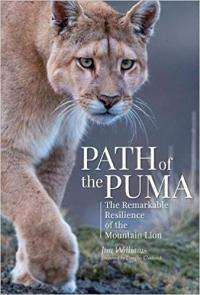Path of the Puma: The Remarkable Resilience of the Mountain Lion
 | |
| Author | Jim Williams |
|---|---|
| Country | U.S.A. |
| Language | English |
| Genre | Non-fiction |
| Published | 2018 |
| Publisher | Patagonia Books |
| ISBN | 978-1-938340-72-7 |
Path of the Puma: The Remarkable Resilience of the Mountain Lion, by Jim Williams, is a non-fiction book presenting the research of the author, a wildlife biologist and supervisor for Montana Fish, Wildlife and Parks' Region 1 in Kalispell. Williams also discusses DNA research conducted by others on these animals, and makes the case for coexistence with these big, wild cats
Synopsis

With a foreword by Doug Chadwick, the book chronicles Williams' journey, from his early work at a Florida marine park, to his conversion to "a lifelong devotee of the species".[1] Williams has fitted pumas (also known as cougars and mountain lions) with radio collars and has installed cameras in their caves to track and study them.[1][2] Publishers Weekly wrote, "Montana-based wildlife biologist Jim Williams celebrates wildlife research and conservation of ghost cats from Canada’s Yukon Territory to Tierra del Fuego in Argentina and Chile..."[1]
Critical reception
Path of the Puma has received positive reviews. Publishers Weekly said, "Williams writes movingly of the challenges these animals face, many due to human encroachment on their habitats. He makes a strong case for the necessity of preserving—or at least peacefully coexisting with—the puma."[1] Kirkus Reviews noted, "While the book is an undisguised conservationist’s plea ... it is not a harangue. The author’s passion and his firsthand knowledge of his subject make the narrative highly readable. A noteworthy feature of this work is the presence of numerous full-color photographs..."[2] Kirkus concluded, "A handsome book that is well-balanced, instructive, and authoritative."[2] The Natural History Book Service wrote that the puma's story, "...is fascinating for the lessons it can afford the protection of all species in times of dire challenge and decline."[3]
Susan Waggoner of PressReader notes Williams' "...enthusiasm for nature and animals jumps off every page... Williams’s writing is expert, friendly, and interesting. Well organized and clearly presented, information emerges from field work examples, such as the tracking studies that showed that pumas feed almost exclusively on wild prey rather than domestic herds."[4] Tristan Scott of the Flathead Beacon wrote, "Path of the Puma doesn’t sugarcoat the risks of predators living among humans — mountain lions live at the intersection of human landscapes, livelihoods and lifestyles — but it points out the critical role predatory species play in the natural world."[5]
References
- 1 2 3 4 "Nonfiction Book Review: Path of the Puma: The Remarkable Resilience of the Mountain Lion". Publishers Weekly. 6 August 2018. Retrieved 2 September 2018.
- 1 2 3 "Path of the Puma: the Remarkable Resilience of the Mountain Lion". Kirkus Reviews. 1 September 2018. ISBN 978-1-938340-72-7.
- ↑ "Path of the Puma: The Remarkable Resilience of the Mountain Lion". www.nhbs.com. Retrieved 2018-09-02.
- ↑ Waggoner, Susan (14 August 2018). "Path of the Puma". www.pressreader.com. Retrieved 2018-09-02.
- ↑ Scott, Tristan (31 August 2018). "Pursuing the Puma - Flathead Beacon". Flathead Beacon. Retrieved 2018-09-02.